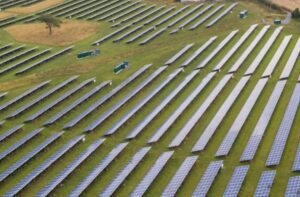An ARENA-funded solar research team at the University of New South Wales has recorded the highest efficiency for a PV system ever reported, converting over 40 per cent of sunlight into electricity, with an innovative take on Australian-designed solar tower technology.
The team achieved 40.1 per cent efficiency in outdoor testing in Sydney in late October, using a solar ‘Power Cube’ system made up of commercially available solar cells, but with innovative efficiency improvements.
“The new results are based on the use of focused sunlight, and are particularly relevant to photovoltaic power towers being developed in Australia,” said UNSW Scientia Professor and Director of the Advanced Centre for Advanced Photovoltaics (ACAP) Professor Martin Green.
The PV system prototype was then transported to the US, where it was re-tested at the National Renewable Energy Laboratory (NREL) in Colorado, achieving an efficiency of 40.4 per cent in early November.
The UNSW team says a key part of the ‘Power Cube’ prototype’s design is the use of a custom optical bandpass filter to capture sunlight that is normally wasted by commercial solar cells on towers – reflecting particular wavelengths of light while transmitting others – and convert it to electricity at a higher efficiency than the solar cells themselves ever could.

efficiency of over 40% measured on that day.
They used solar power towers being developed by Australian company RayGen Resources, which provided design and technical support for the high efficiency prototype.
Another partner in the research was Spectrolab, a US-based company which provided some of the cells used in the project.
“The clever solution combines advanced triple junction cells with cheaper conventional silicon cells to boost power output,” said Ivor Frischknecht, CEO of the Australian Renewable Energy Agency (ARENA), which contributed $550,000 towards the $1.3 million project.
“Light that is normally wasted by triple junction cells is captured by splitting incoming sunlight into different spectra and directing some of it into a silicon cell,” Frischknecht said.
“This approach has achieved a higher efficiency than what is physically possible with a triple junction cell alone.”
Frischknecht said the breakthrough could have practical applications for concentrated solar power PV towers, where sunlight is reflected from a field of sun tracking mirrors towards a central receiver.
“Instead of using mirrors to heat a medium like salt, the high tech receiver converts light to electricity directly, like a rooftop solar panel does,” he said.
“This project is an excellent example of ARENA achieving true innovation with real-world commercial application through investment in solar research.
“We hope to see this home grown innovation take the next steps from prototyping to pilot scale demonstrations.
“It has real potential for RayGen Resources’ concentrating PV power tower technology, currently being commercialised through another ARENA supported project.
“Ultimately, more efficient commercial solar plants will make renewable energy cheaper, increasing its competitiveness.”
The new record is the latest in a long line of achievements by UNSW solar researchers, including a 1989 record of the first photovoltaic system to convert sunlight to electricity with over 20 per cent efficiency – a result it has now doubled.
The research was also supported by the Australia-US Institute for Advanced Photovoltaics (AUSIAPV).








